Everything You Ever Needed to Know About Content Marketing
- December 16, 2019
- Uncategorized
Call us biased, but content marketing rocks.
For businesses:
Content marketing is a powerful strategy for building and engaging an audience of future customers. In fact, we’d even say that content marketing is downright essential for most companies today.
For marketers:
Content marketing is a rewarding and fast-growing career path. You get to dive into interesting topics and turn that material into entertaining and educational content that engages your customer base—while feeling good about the fact that you’re fulfilling a critical role for your company.
For users:
By “users,” we’re talking about the people actually reading your articles… watching your videos… playing your podcast in the car.
These are your customers, your leads, your audience.
And for these people, content marketing is fun! It’s engaging! It’s educational!
It’s informative, profound, timely, scary, funny, interesting, shocking, moving, binge-worthy, share-worthy, like-worthy, click-worthy, and most of all: VALUABLE.
We’re going to come back to the idea, again and again, that your content needs to provide real value for your users.
If that’s the only thing you learn in this article, it will have been well worth your time.
But don’t worry. You’re going to learn a lot more than that, including how to…
- Develop a killer content marketing strategy
- Fit content marketing into the Customer Value Journey
- Create content for each stage of the marketing funnel
- Choose the content types that make the most sense for your business
- Quickly come up with loads of great content ideas
- Create content more quickly and easily by repurposing it
- Use an editorial calendar and style guide to ensure your content is consistent and on-brand
- Distribute your content to the right people at the right time
- Monetize your content through 4 key strategies
- Track and improve the performance of your content over time
Let’s get started. And since we’re about to spend a lot of time talking about content marketing, it probably makes sense to start by clarifying…
What Is Content Marketing?
Let’s make sure we’re all on the same page. Here’s how we define what content marketing is:
“Content marketing is the creation and distribution of valuable content to build and engage an audience for your brand.”
That’s a mouthful, so let’s break down that definition to make sure we’re all clear.
“Content marketing is the CREATION and DISTRIBUTION…”
We’ve emphasized 2 words here, creation and distribution, to drive home the point that content marketing involves both.
You can’t just create a great blog post, publish it, and expect that to move the needle for your company.
Instead you need to take charge of distributing that content to the right people at the right time, to make sure that content has the maximum possible impact.
“…of VALUABLE content…”
We told you we were going to hammer home this “valuable” thing. Well, here it is again.
Good content marketing has to provide value for your user. If it doesn’t, then it’s not going to be very effective.
With content marketing, you’re providing value—for free—in exchange for time. The more time someone spends with your content, the more they will begin to know, like, and trust you.
Do that over and over, and people will begin to trust you enough to shell out some hard-earned cash for your product or service.
“…to BUILD and ENGAGE an audience for your brand.”
And here we get to the real point of all this stuff. Content marketing is how you build an audience.
Make no mistake: the ultimate goal of content marketing is to benefit your company. And when it’s done right, it will accomplish that by growing your traffic and, consequently, your sales.
The Different Types of Content
Now that we have a working definition of content marketing, let’s dive into some of the specific forms your content can take.
Blog
Blog posts are what most people think about when they think about content. And they’re right: cultivating a good blog can be an excellent way to deliver value and build an audience.
But the truth is, content can include waaay more than just blog posts. Don’t get us wrong: blogs can still be super important and super effective. But with over 500 million blogs online today, it can be hard to stand out from all the noise.
So, here are some of the other types of content you can create:
Videos
Video is an incredibly powerful form of content, and it continues to become more and more important every year—particularly with internet speeds and phone cameras getting better and better.
A cool thing about videos is that they can live in a variety of places. The most well-known home for video content is undoubtedly YouTube. It’s the world’s second-biggest search engine, and a terrific place to build an audience.
But you can (and probably should) also distribute video content on social media (like Facebook and Instagram) and on your own website.
One common misconception regarding video content is that a lot of people think their video has to be super complicated and highly polished to be effective.
But it doesn’t!
You don’t need a huge budget to craft highly effective video content. In fact, YouTube is full of incredibly popular videos that were shot on a simple phone camera.
So, if you want to leverage the power of video in your content strategy (and we highly recommend that you do), don’t wait. Get started now, using the equipment you have available, and improve your setup over time.
Podcast
Podcasts continue to be a great way to reach new audiences.
After all, people need something to do while they’re driving to the office, working out at the gym, or standing in line at the grocery store. Audio-only content like a podcast makes perfect sense in situations like these, where the person can’t afford to be watching a video.
Email Newsletter
There are a lot of companies out there that use email for one purpose, and one purpose only:
To promote the ever-loving heck out of their products.
The message in every email is: “Here’s a product! Buy it!”
As you might imagine, that gets old quick. And if that’s all you ever email to your list, you’re probably driving people away with your over-aggressive email strategy.
It’s a shame, too. Because email is potentially a wonderful medium for delivering value-packed content.
Email newsletters have been around for a long time, but it feels like they’re gaining popularity again. An email newsletter is simply a regular email that delivers free, valuable content through email only.
Think of it like a tiny little newspaper… one that’s focused on a specific topic… and delivered via email.
One awesome side-effect (or maybe it’s just an effect) of this strategy is that it trains your audience to open your emails, because they’ll come to associate your emails with content and VALUE, rather than another sales promotion asking them to buy something.
(There’s that V word again!)
Any Other “Free” Content Medium
The examples above are some of the most common content types. But they aren’t the only types! Content can take many different forms.
In a nutshell: if you can use it to deliver value for free, you can use it for content marketing.
For example:
- Ebooks. Typically stored as PDF files, ebooks are a great way to distribute long-form content. (They also make terrific Lead Magnets.)
- Physical books. Believe it or not, people still read these! The cool thing about a physical book is that it lends you a tremendous amount of credibility and trust. It also gives your prospects a physical reminder of you.
- Other newsletters. We talked about email, but that’s just one way to distribute regular content. You could achieve the same thing through a physical newsletter you send in the mail, or even through a chatbot newsletter you run through Facebook Messenger.
- Images. Images usually need text to go along with them, but in some cases, an image by itself is enough. The right image can work like a charm on certain social media platforms (think Instagram, Pinterest). And a good infographic can generate tons of shares and traffic.
By diversifying your “content portfolio” to include other mediums like video and podcasts, you can safeguard your content strategy against algorithm changes and attract a larger audience.
But just to clarify: you do NOT have to use all of these content types. In fact, you probably shouldn’t.
Because first of all, if you spread yourself too thin, you won’t have the time or resources to do an outstanding job at any one content type. And second, not every content type will fit your brand, your team, and your goals.
OK. At this point you should have a good idea of what content marketing is, and what various forms it can take.
The next important thing to understand is how this content marketing fits into the bigger picture. So let’s dive in.
How Content Marketing Fits into the Customer Value Journey
If you’re a seasoned marketing pro, you’re probably familiar with some form of the customer journey. This is the idea that people go through a series of stages as they progress from stranger to customer.
Here at DigitalMarketer, we call that “The Customer Value Journey” (CVJ for short). Here it is, in all its glory:
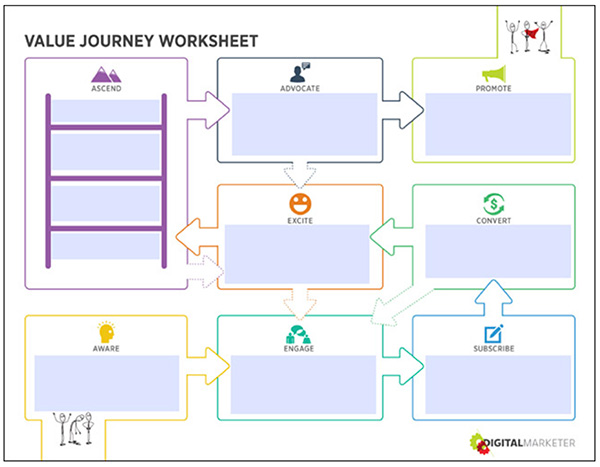
In a nutshell, here’s how the CVJ works:
- First, someone how to become AWARE that you exist in the first place.
- They need to ENGAGE with your content—reading your articles, watching your videos, etc.
- They SUBSCRIBE to become a lead (typically by providing their email address).
- They CONVERT by making their first purchase, making them a customer.
- They get more and more EXCITED about your product or brand when you deliver a great customer experience.
- Over time, they ASCEND by making additional purchases.
- Eventually, they become an ADVOCATE by providing passive recommendations (such as leaving a good review).
- Finally, your best customers will become active PROMOTERS of your brand by recommending your products to their friends, family, and/or audience.
Content marketing is primarily concerned with 4 stages of the CVJ: Aware, Engage, Subscribe, and Excite:
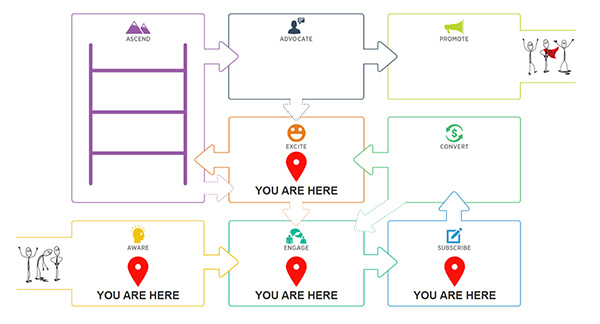
These are the places where your content can really shine and help move people through the 8 stages of the Customer Value Journey.
How Content Creates Awareness
Content can be a powerful way to generate awareness. To do this successfully, you need to understand how people find content online. Two of the most common ways include the use of search engines and social media.
So it’s important to optimize your content for maximum visibility on these platforms.
For example, if you were just dipping your toes into digital marketing, you might Google a phrase such as: “How to do digital marketing.”
If so, you would see our Ultimate Guide among the first-page organic results:

If you clicked on this result and checked it out, making it your first experience with DigitalMarketer, you would have become aware of our brand.
How Content Creates Engagement
This is a fragile stage in the CVJ. People at this stage know about you, but they don’t yet trust you enough to give you their email address.
One of the best ways to build that trust level is to provide helpful content that gets visitors to engage with it.
Engagement could mean a lot of things. It could mean watching one of your videos, commenting on a Facebook post, or even reading one of your blog posts.
To continue with our example, if you clicked on our organic listing and read through some of our “Ultimate Guide to Digital Marketing,” you would now be aware of DigitalMarketer and you would have engaged with at least one piece of content.
How Content Generates Subscriptions
At this stage, it’s time to present your visitors with an attractive offer. You’re not trying to sell them a product just yet; instead, you’re still providing value for free in order to build trust and credibility.
The main difference at this stage is that you’re requiring the person to opt-in to get this free content. Here’s an example of one of our Lead Magnets that works really well. Notice how we make a very clear offer—something that promises to deliver a strong benefit:

When someone takes you up on this offer and subscribes to your list, they have officially become a lead. You can now follow up with them over time, providing even more valuable content to continue to build up their trust in your ability to help solve whatever problem they’re facing.
How Content Creates Excitement
At this point, your visitor has paid you some money. They’re no longer just a lead; they are now your most valuable group of people—CUSTOMERS.
So take good care of them. Continue to provide high-value content, so that they’ll be happy they decided to buy your product.
Do a good enough job, and you’ll set the stage for the next step of the CVJ—Ascension, in which your customers buy from you again and again.
Now you know how content marketing fits into the big picture by helping to generate awareness and move people through the steps of the CVJ toward becoming a customer and promoter of your brand. But there’s another content marketing model you’ll need to understand, and that’s the concept of full-funnel content.
(Note: How do you create awareness, engagement, subscriptions, and excitement? By saying the right thing to the right people. Not sure who your customer avatar is? Sign up for DM Insider for FREE and get your Customer Avatar Worksheet to figure out who your customer is.)

Why You Need Full-Funnel Content
Hang out with marketing nerds like us long enough, and eventually you’re bound to hear the term marketing funnel. And along with it, some more specific terms like top-of-funnel, middle-of-funnel, and bottom-of-funnel.
Marketers frequently use the analogy of a “funnel” to help visualize the flow of leads into your business. Usually it looks something like this:
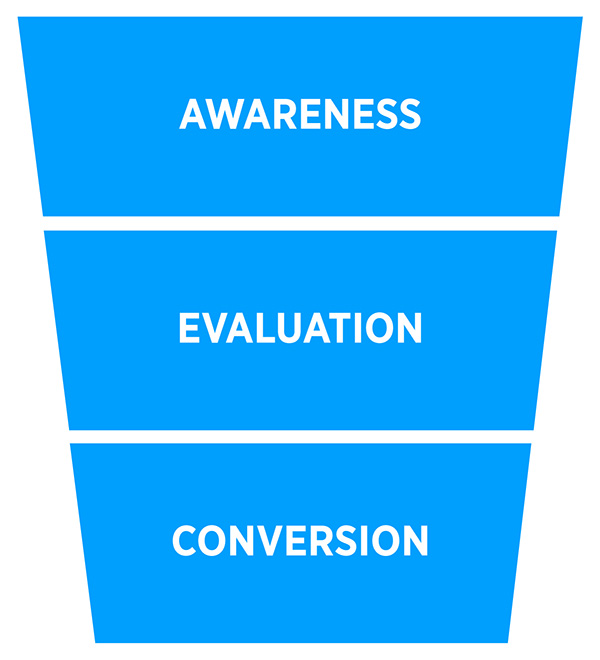
The helpful thing about this model is that it makes it easy to visualize the direction people go through. It also makes it clear, at a glance, that there are always people “falling out” of your funnel.
That’s why the top of the funnel is the biggest and the bottom is the smallest; because for every conversion (AKA purchase) you generate, there are bound to be a handful of people still evaluating your product. And for every one of those people, there are bound to be a handful of people just becoming aware of you.
The reason we bring this up is because, as a content marketer, part of your job is to create content that fits in the top, middle, and bottom of this funnel. In other words, you need to create full-funnel content that speaks to people in each of these 3 stages.
If you don’t, you’ll find that people have a tendency to “get stuck” at a certain point in your funnel.
In other words, your content has to be tailored to the knowledge level of your users as they progress through the buying process. Your content serves a slightly different purpose at each of those different stages of the funnel.
To learn more about how this works, let’s dive into each of the 3 stages in more detail.
Top-of-Funnel (TOFU) Content Facilitates Awareness
Anytime someone becomes aware of your company, they’re entered into the top of that funnel. At DigitalMarketer, we use the term “TOFU” for “top-of-funnel” because it’s shorter and because using acronyms makes us feel smart.
The job of TOFU content is to grab people’s attention and spark their interest. To do that, your content typically needs to entertain, educate, and/or inspire them to learn more.
Here at DigitalMarketer, we want our TOFU content to be simple enough to appeal to digital marketing beginners… while still being detailed and useful enough to provide real value. It’s a bit of a balancing act.
TOFU content can take many forms, including…
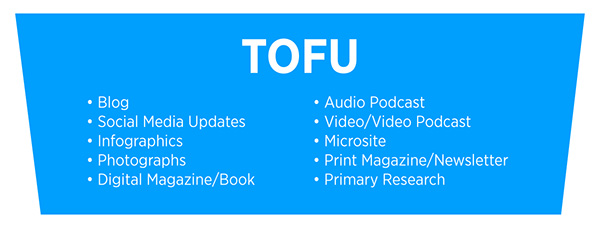
Keep in mind, you won’t need ALL of these content types. Instead, choose the few that work best for you and stick with what works.
Middle-of-Funnel (MOFU) Content Facilitates Evaluation
As that person progresses through your marketing funnel—seeing your ads, engaging with your content, opting into your list, and so on—we think of them as being in the middle of your funnel (MOFU). At this stage, the person is in the process of evaluating your product or service.
People at this stage are already aware of you, but they’re not yet ready to buy. So you’ll need to create content that helps move people through your marketing funnel, turning them into leads.
Here at DigitalMarketer, we rely on MOFU content to generate a lot of our subscriptions. We do this by offering our visitors slightly more advanced content in the form of a Lead Magnet, which they can get for free when they sign up for an Insider account.
And just like TOFU content, Lead Magnets can take many different forms. Such as…
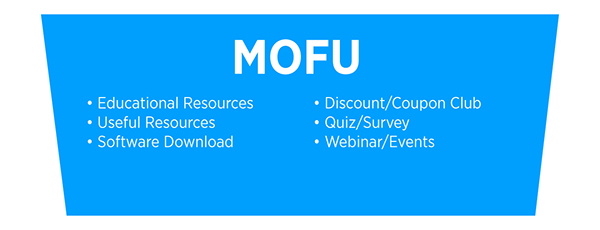
Bottom-of-Funnel (BOFU) Content Facilitates Conversion
Last but not least, bottom-of-funnel (BOFU) content is targeted at people who are close to making a purchase decision.
People at this stage are already familiar with your product or brand. In many cases, they may be deciding between your product and a competitor’s. They may be debating whether or not your product is worth the cost. Or, maybe they’re just dragging their feet and need a good reminder of how much your product will help them.
Good BOFU content can help push these people over the edge and convince them to click that “Buy” button. It does this by…
- Overcoming any lingering objections
- Facilitating favorable product comparisons
- Making it easy for prospects to make a purchase
When creating BOFU content, think about some of your most common questions and buying objections. What kind of content can you create that will address those points?
And once again, BOFU content can take different forms…
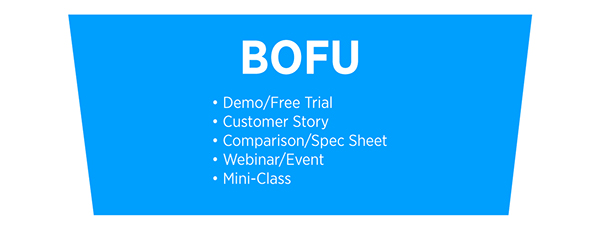
Hopefully, you’re starting to understand that good content marketing isn’t created haphazardly. Instead, successful content is created according to a specific strategy that’s designed to maximize the performance of your content at each stage of the marketing funnel.
And speaking of content marketing strategy…
Here’s How to Craft a Killer Content Marketing Strategy
All right. How you feeling? Still going strong?
This might be a good time to re-energize yourself with a couple jumping-jacks. Or if there are people around, maybe just a cup of coffee. However you do it, you’ll want to make sure you’re paying close attention to this part.
Because we’re about to dive into how to build out a content marketing strategy.
Your content marketing strategy is your game plan. It’s what prevents you from rushing into the blind, haphazard creation of individual pieces of content that don’t actually fit together as part of a cohesive whole.
A good content marketing strategy will also clarify things like…
- What kind of content you will create (Blogs? Videos? Podcasts?)
- How often you’ll publish each kind (Daily? Weekly? Twice a month?)
- Which customer avatar(s) you will target (Vegan moms? Golf enthusiasts? SaaS entrepreneurs?)
You’ll also want to make sure your strategy calls for the creation of content that fits into all the appropriate steps of the Customer Value Journey.
AND you’ll need to include a mixture of casual, beginner-friendly content, and more advanced and tactical content, to make sure you’re appealing to people in all 3 stages of the marketing funnel (TOFU, MOFU, and BOFU).
Phew. That’s a lot of objectives to achieve. Are you starting to see why your content marketing strategy is so friggin’ important?
Yeah. We see you nodding your head.
All right, then: let’s get down to brass tacks. How do you actually DO this? What does a content marketing strategy actually LOOK like?
The truth is, there’s no one way to do it. Every company’s content strategy is liable to include different information, depending on their unique needs.
What we recommend is to start with something basic—we’ll give you a simple framework in just a minute—and then let it evolve over time as you learn more about what’s important for your business.
We recommend starting with some basic questions:
- What TYPES of content will you publish? (Blogs, videos, etc.)
- How FREQUENTLY will you publish each of these content types? (Daily, weekly, monthly?)
- What DISTRIBUTION VENUES will you use to help people find your content?
- What KPIs will you use to track the success of each type of content? (We’ll talk about KPIs in the next section.)
Having all these details inside a document can be incredibly valuable, because it helps you to make better content decisions. We do this for every content type separately—here are a few examples.
Our blog strategy:
- Publish twice a week
- Mixture of casual & tactical content
- Promote on social and via email
- Focus on keyword strategy in “content clusters”
Our podcast strategy:
- Publish twice a week
- Mixture of thought-provoking interviews and tactical, how-to information
- Promote on social media
Our video strategy:
- Focus on engaging TOFU videos
- Publish weekly update series
- Include formative tips and tactics for social media and YouTube
One reason why it’s helpful to create separate strategies for each content type is because depending on your business, you may use different content types to focus on different parts of the marketing funnel or the Customer Value Journey. For instance, maybe you focus on YouTube videos to generate awareness (TOFU), and then focus on blog posts to move people through the MOFU and BOFU.
And remember, your content marketing strategy can be as simple or as in-depth as you need. If you’re just getting started, stick with the basics for now. You can always expand your strategy as you learn more about what you need to succeed.
That leads us to one more important point to remember…
Give Your Content Strategy an Expiration Date
Before we move on, we think it’s important to point out that your content marketing strategy is NOT a “set it and forget it” type of document.
Your content strategy can and should change over time.
Why?
Because your company is changing. Because the marketplace is changing. Because the traffic platforms and search algorithms are changing.
In short, things are constantly changing (especially online). And your strategy will need to grow and adapt to stay relevant.
For that reason, we recommend revisiting and reevaluating your content marketing strategy at least every year. Take a good, long look at your content efforts over the past 12 months and decide what’s working, what’s not, and what needs to change to keep up with the ever-evolving landscape.
At this point, there’s one thing you may be wondering: how, exactly, are you supposed to know when your content is performing well and when it isn’t?
That’s a great question.
And that’s what we’re going to cover next.
Content Marketing KPIs
There’s a saying in content marketing:
Beer before liquor, never been sicker. Liquor before beer…
Wait. Sorry. Wrong saying. 
What we were trying to say was:
“What gets measured, gets managed.”
In other words: if you want to improve something—such as the performance of your content marketing—you have to measure and track it over time.
But how do you do that? How do you know when a piece of content rocks the party, and when it sucks the big one?
That’s where content marketing KPIs come into play.
KPIs (key performance indicators) are the important metrics that you will keep a close eye on for each piece of content.
Here are some of the KPIs we track for our different types of content:
Blog KPIs
For blog posts, the metrics we track include:
- Pageviews: How many total pageviews did we have on our posts? Pageviews is a bit of a vanity metric, and a lot of people overestimate the importance of them. But it’s still a good idea to keep your finger on the pulse of how many people are viewing your posts in any given period.
- Organic sessions: How many sessions came from organic traffic specifically? If SEO is a big part of your strategy (like it is for us), you’ll certainly want to keep a close eye on this.
- Ranking keywords: This refers to how many of your keywords rank in the Google search engine results. Don’t freak out if this number jumps around a lot; that’s common. But it’s still helpful to keep track of this for SEO purposes.
- Email subscriptions: How many email opt-ins is your content generating? This is an extremely important metric for a lot of companies, making it a critical content marketing KPI.
Video KPIs
Your KPIs for video will probably vary depending on the platform(s) where you distribute them. We’ll focus on YouTube, where it’s important to track these metrics:
- Subscriptions: Your number of subscribers might just be the #1 most important metric on YouTube, since this is the best approximation of your audience on this platform. As you publish more and more videos over time, you certainly want this number to increase.
- Likes & comments: These metrics help give you an approximation of how much people are engaging with your content. The more likes and comments, obviously, the better. On YouTube, you can also track your ratio of likes to dislikes. And for more in-depth analysis, you can read through your individual comments to get a better idea of what people are saying about your content.
- Views: It’s no accident that we put views last in this list. This is another vanity metric that people have a tendency to take too seriously. Yes, more views is generally better (all other things being equal). But think about your views in context with the metrics above. If you’re getting a lot of views, but little engagement and few subscribers, that might be a sign that you’re catching people’s attention with your headline and thumbnail—but then failing to deliver the kind of value they’re looking for in the video itself.
For an example of a video that doesn’t quite deliver on its promise, consider the blender company Blendtec. Blendtec is known for creating popular videos in which they use their blender to demolish expensive electronics like iPhones and iPads.
And in this video, called “Will It Blend? – Crowbar,” they promise to take their demonstrations to the next level by using their blender to turn a crowbar into dust:
It’s a great promise, and one that’s generated a lot of views over the years:

However, when you watch the video, you’ll be disappointed when they do NOT try to blend the crowbar. Instead, they replace the crowbar with a handful of phones and blend those instead.
It’s still an impressive display for a blender… but it feels like a bait-and-switch. And that’s undoubtedly why this video has more dislikes than likes:

(By comparison, most of their other “Will It Blend” videos have far more likes than dislikes.)
This is a good example of why views don’t tell the full story, and why you need to balance an intriguing headline with content that can deliver on your promise.
Podcast KPIs
And here are the metrics we focus on for our podcasts:
- iTunes ranking (within your podcast type): Your iTunes ranking is a good approximation of how popular your podcast is, relative to your competition. Just make sure to look at this within your podcast type, because that’s much more helpful than looking at your overall ranking.
- Downloads: This refers to how many people downloaded your episodes. You can look at this in aggregate, or for an individual episode. Over time, your number of downloads should be growing; and you can usually tell which episodes are the most popular because they’ll have the most downloads.
- Show notes page conversions: Finally, don’t forget about your show notes pages! In some cases, you may put a call-to-action on these pages—like a link to read a blog post, sign up for a lead magnet, or even buy a product. Keep an eye on how many people take these actions, because it will help give you a better idea of how well your podcast is actually moving the needle for your business.
How to Make the Most of Your KPIs
We’re about to leave KPI-land, but before we do, we have one parting piece of advice:
Document your KPIs over time, and look for trends.
One isolated piece of data is meaningless.
For example: if you knew that one particular video got 1,000 views last month… how would you know if that’s good or bad?
You wouldn’t, unless you could put that number into context.
Maybe that video got 800 views last month, 600 the month before, and 400 the month before that. In this case, you can reasonably assume that this video has hit on a trending topic and/or has risen in the search rankings.
Or, maybe your average video got 3,000 views. In this case, it might be a sign that this video is underperforming compared to your average. If so, think about why that might be the case. Does it have a subpar headline or thumbnail? Is it targeting a more competitive keyword? Was it published at a bad time?
Now, don’t be too quick to change things. You want to give your content strategy a fair shot to learn if it’s working or not.
But if your content is consistently underperforming, that’s a clear sign that it’s time to stop doing what you’re doing and try something else. You want to always be optimizing your content.
And the only way to know if that’s the case, of course, is by diligently tracking and evaluating your KPIs.
How to Come Up with Great Content Ideas
One of the things people often ask is:
How do I come up with good content ideas?
It’s a great question.
One of the most common strategies is to find out what questions people are asking that are relevant to your product or service. Once you know what information people are looking for, creating content that answers those questions becomes fairly straightforward.
And fortunately, there are some really helpful online tools you can use to narrow down what kind of content to create. Some of the more useful ones include…
- Quora
- Facebook groups
- Google Keyword Planner
(Note: The first step to coming up with great blog post ideas is knowing who you are writing for (and selling to). Not sure who your customer avatar is? Sign up for DM Insider for FREE and get your Customer Avatar Worksheet right now!)

3 Strategies to Help You Create Consistently Awesome, On-Brand Content
Hopefully, you’re starting to get a better idea of how content marketing works. You should have an idea of what content marketing is, how it fits into the Customer Value Journey, how to create an effective content strategy, how to measure the impact of your content’s effectiveness with the right KPIs, and how to come up with a long list of great content ideas.
Now let’s dive a little deeper into the nitty-gritty of how to actually create effective content on a consistent basis. And there are 3 powerful strategies that will help you do it.
Strategy #1: Create an Editorial Calendar
In content marketing, consistency is critical. You want to make sure your content is published on a regular basis so that your audience knows when to come back.
That’s why we recommend the use of an Editorial Calendar.
With an Editorial Calendar, you’ll gain a big-picture view of what content you’re going to publish, and when. This makes it easier to be more strategic about your content creation (rather than just haphazardly publishing on random topics as they occur to you, like many companies do).
Just like your content strategy, your Editorial Calendar can be as simple or complex as you need. At a bare minimum, we recommend at least including details like content type, title, publish date, and author for each piece of content. But you can also include any of the following, or more.
- Calls-to-action to be included
- Which stage of the CVJ it fits into
- Outbound or internal links
- Any related promotions
- Work assignments for freelancers
Having an Editorial Calendar becomes especially helpful when you have multiple authors and/or freelancers to keep track of.
Strategy #2: Create a Style Guide
One of the most underrated aspects of effective content marketing is having a unique brand voice.
Your brand voice is the personality that shines through in your content.
Why is having a brand voice so important?
Because at the end of the day, with millions of people posting content online, it’s hard to have content that’s truly unique. That’s just a fact of life online today.
But that’s OK. Because you can still set yourself apart from the competition by delivering that content in a way that’s unique—by developing and sticking to a consistent brand voice.
For example, take this post on shallots from Bon Appetit. You only need to read the very first paragraph to get an idea for Bon Appetit’s irreverent brand voice:
“When my editor was like, “Do you want to write a story about shallots,” I jumped at the opportunity to better know my favorite allium. I opened up Alfred, Lord Tennyson’s famous poem about them, only to learn it wasn’t about shallots at all, but some lady. Of Shalott. No relation. Boo!”
One of the challenges in having a brand voice is the issue of consistency. How can you make sure all the content you produce has the same voice, tone, and style?
The answer is to create a style guide.
Your style guide is a document that lays out the rules you can follow to achieve a consistent brand voice—even if you have multiple different people writing for your site.
This document should exemplify your brand’s voice, including topics like…
- Grammar
- Voice/personality
- Design
- Use of industry-specific words
- Blog or video guidelines
A good style guide can help you avoid inconsistencies, give your content a cohesive feel, and make your company appear more professional and trustworthy.
Strategy #3: Repurpose Content
Finally, here’s one tip that can dramatically (and efficiently) speed up your content creation:
Repurpose your content.
The reason why this is a great strategy is because once you’ve taken the time to create one piece of content, it’s faster and easier to repurpose it than to create another brand-new piece of content.
There are many different ways to do this. You can start with a video, then hire a writer to turn it into a blog post, and finally pull out 4-6 quotes and statistics from that post to be used as social media content.
Or you could start with a podcast and follow a similar process.
For example, we recorded a video presentation that taught marketing agencies how to get more clients.
We turned that video into a blog post called, “The Perfect Pipeline: How to Fill, Nurture, and Grow Your Digital Marketing Agency.”
We then used that one blog post to create 5 pieces of social media content:
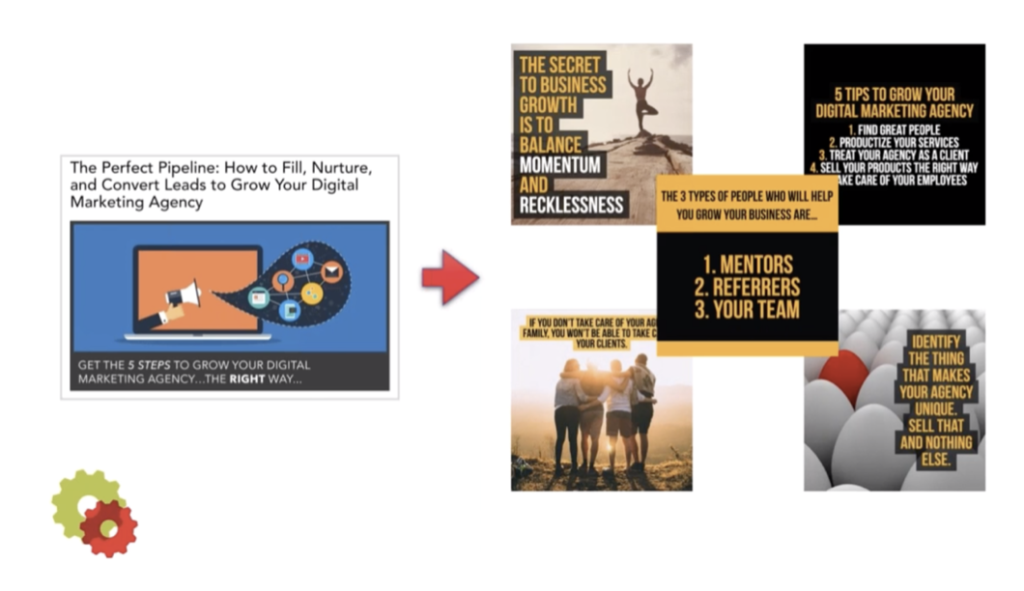
As you can see, this is a great way to get the maximum possible mileage out of every new piece of content you create.
Content Distribution
Creating great content is only half the battle.
You also need to figure out how you’re going to distribute that content—in other words, how you’re going to get that content in front of the right people so it can do its job.
Some of the most common and effective methods we use to distribute our content includes…
- SEO: By optimizing your content for the right keywords, you can generate a steady stream of free organic traffic
- Email marketing: Anytime you publish a new piece of content, send it out to your email list! This is a great way to keep in touch and continue building value with your audience
- Social media: Share your content on Facebook, Instagram, and other social platforms to help keep your followers engaged and to gain exposure to new audiences
- Run ads:Anytime we publish a new post, we’ll pay to boost it on platforms like Facebook. This helps dramatically improve our reach
Don’t make the mistake of assuming that people will find your content on their own. In most cases, you’ll need to actively promote your new content to get it in front of them.
How to Monetize Your Content
Throughout this guide, we’ve talked over and over again about how important it is for your content to provide value for free.
But that doesn’t mean you can’t also monetize your content!
Because at the end of the day, your goal with content marketing is to generate revenue—right?
Of course it is.
The good news is that you CAN generate revenue through content. Here are some of the ways you can do it:
- Run ads in your content. This is how most publishers monetize. Keep in mind that in order for this strategy to work, you have to continue delivering value to keep people coming back again & again. (Most publishers also publish a LOT—as in multiple posts per day.)
- Run sponsored content. Another strategy is to promote products from a partner in exchange for payment or a percentage of affiliate sales. For this strategy to succeed, it’s important to make sure your partner’s offer makes sense for your audience and has the potential to provide them with real benefit.
- Monetize your YouTube content. You can also enable YouTube ads to generate additional revenue from your videos. In our experience this ad revenue can be inconsistent, but at the very least it can help offset your video production costs.
- Drive people toward making a purchase. At the end of the day, the most powerful way to monetize your content is to make sure it drives people closer to making a purchase.
For an example of a piece of content that drives people toward making a purchase, take this video by Saddleback Leather called, “How to Knock Off a Saddleback Leather Co. Briefcase”:
In this video, the owner (Dave) walks you through the construction of their bags step-by-step. Under the guise of teaching competitors how to knock off his bags, he explains all the little details that go into his products—such as the high-quality leather, the rust-proof hardware, and even the unbreakable thread they use.
Basically, he’s teaching you how to appreciate the quality inherent in his product.
Anyone who watches this video will come away with a much better understanding of why Saddleback Leather bags are so much better than the competition… and they’ll be much less likely to settle for a substandard product.
Content Marketing Tools You May Want To Try
We’ve covered a lot of ground in this guide. And at this point you may be wondering:
How do I actually *do* all this stuff?
Fortunately, there are some really helpful tools out there that can save you time while helping you to perform some of the most important tasks in content creation.
Here are some of our favorite tools:
Blogging Tools
- SEMrush isn’t cheap, but it’s a powerful SEO tool that can help you learn more about what it will take to rank for high-value keywords.
- Keywords Everywhere is another SEO tool. It doesn’t have the same extensive features as SEMrush, but it’s a much cheaper option that still provides some really valuable keyword information.
- Google Analytics is essential for learning more about how people are engaging with your blog post. You’ll see helpful metrics like your bounce rate, time on site, average pages visited, and more.
- Answer the Public is a service that will show you what kind of questions people have asked about certain topics. It’s a great way to come up with content ideas that are more varied, specific, and helpful.
- WordPress is the most widely used content management system online, powering more than 60 million websites. It’s easy-to-use, SEO-friendly, and a great option for hosting your blog.
Writing Tools
- Microsoft Word. You can’t go wrong with this tried-and-true word processor.
- Google Docs. The best thing about Google Docs is that your files are all saved online, making them accessible from anywhere in the world. As a result, this is a fantastic tool for collaboration. You can add comments and work together on a document with team members, even if they’re halfway across the world.
- Hemmingway Editor is a great way to get an overview of how readable your content is. Just copy your writing and paste it into Hemmingway Editor, and it will give you an estimated reading level for your content. Aim for a reading level of 8th grade or lower. If it’s higher than that, look for highlighted words & sentences to simplify.
- Grammarly is an extension that helps with spelling and grammar suggestions. It might seem basic, but trust us—nothing screams “AMATEUR” more than content that’s riddled with grammatical mistakes.
Video Tools
- Stock video sites allow you to fill your videos with royalty-free footage. Two such services that we’ve used in the past include Videoblocks and Videohive.
- Adobe offers some top-shelf video editing and production software, including Premiere and After Effects. They come with a learning curve, but allow you to do some amazing things with your video files.
- iMovie and Windows Movie Maker are two free video-editing options for Macs and PCs, respectively.
Podcast Tools
- Skype is an easy way to record and save interviews for your podcast.
- GarageBand is a beginner-friendly Mac option for editing your audio files. (If you use a PC, consider Audacity instead.)
- Libsyn is our preferred hosting option for podcasts. Ever wonder how podcasts get added to iTunes or Stitcher? Well, if you use a tool like Libsyn it happens automatically. For a low monthly fee, Libsyn will host your podcast episodes and automatically sync your show with all the major podcast platforms.
These are great tools, but don’t feel compelled to use all of them. The most important thing is to find what works for YOU. So use these suggestions as a starting point, but keep an open mind about switching if a better tool becomes available.
Also: don’t let a lack of tools become a barrier to getting started. It’s better to use what you’ve got, and create something, rather than procrastinate.
Parting Words of Wisdom
So there you have it: everything you ever needed to know about content marketing.
It’s a lot to take in, so don’t feel like you need to master everything right away. Take it one step at a time. Before you know it, you’ll have a full-blown content marketing strategy in place that attracts new prospects, builds trust in your brand, and ultimately grows your sales & revenue.
And while we still have your attention, we want to leave you with a few important takeaways:
- Be patient. Content marketing is not a quick play. It can take time to see success—especially through SEO. Stick with it, and give your strategy a chance to succeed.
- Don’t wait. We’ve seen far too many companies procrastinate, promising they would get around to content marketing “soon.” Problem is, “soon” doesn’t ever seem to come around. There will always be something else you could be doing instead of content marketing. But trust us when we say that this is a vital part of your business that you NEED to focus on. Now.
- Value, value, value. The theme of this article is value. At every step in your content marketing journey, make sure you’re actually doing something to help your visitors. Do that, and you’ll go far.
Now get out there and start growing your business with awesome content.
P.S. Want even more content marketing resources? Check out the blog posts below to take your content marketing to the next level!
- The 12-Week Year Strategy for Your Content Calendar
- How to Find Writers for Your Blog
- Your Content Probably Isn’t Unique (But This One Thing Can Help)
- 17 Best Podcasts of All Time For Content Marketers
- 3 User-Centric Content Optimization Tactics You are Not Using But Should Be
- 14 of the Best Marketing Newsletters You Should be Subscribed To
- Top Marketing Blogs to Follow
- Build an Editorial Calendar in Minutes
- Top 16 Content Marketing Tools of 2019
- The Future of Content Marketing and How to Adapt: Trends, Tactics, and Tools
- The Ultimate List of Blog Post Ideas
- Content Writing Tips to Write Better Content (This 7-Step Process Can Work for Anyone)
- 5 Lightning Fast Ways To Create Stellar Blog Content (Even if you hate to write)
- The Perpetual Content Calendar: A 3-Step Framework to Generate Content with a Lean Team
- 3 Simple Steps to Creating A “Pillar Blog Post” That Generates Organic Traffic for Years to Come
(Note: What is “awesome” content? It’s content that your customer avatar is dying to read, watch, and listen to. Not sure who your customer avatar is? Sign up for DM Insider for FREE and get your Customer Avatar Worksheet right now!)

The post Everything You Ever Needed to Know About Content Marketing appeared first on DigitalMarketer.
About us and this blog
We are a digital marketing company with a focus on helping our customers achieve great results across several key areas.
Request a free quote
We offer professional SEO services that help websites increase their organic search score drastically in order to compete for the highest rankings even when it comes to highly competitive keywords.
Subscribe to our newsletter!
More from our blog
See all postsRecent Posts
- Web Hosting September 26, 2023
- Affiliate Management September 26, 2023
- Online Presence Analysis September 26, 2023

